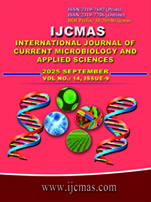Phytoremediation Potential of Indigenous Plants in Abia State, Southeastern Nigeria: A Multi-Site and Multi-Season Assessment
Phytoremediation Potential of Indigenous Plants in Abia State, Southeastern Nigeria: A Multi-Site and Multi-Season Assessment
*Corresponding author
Abstract:
Heavy metal contamination of agricultural soils is widespread in southeastern Nigeria due to legacy Pb–Zn mining and industrial discharges. To evaluate indigenous species for phytoremediation across multiple contaminated/control sites and seasons, quantifying bioavailability, plant accumulation/translocation, antioxidant responses, biomass-driven metal removal, and economic feasibility. Three contaminated (Uturu Ugwu-ele, Lokpaukwu, Ihube) and two control (Ugwunwangwu Uturu, Amuvi) sites were sampled in wet (Jun–Aug) and dry (Dec–Feb) seasons. At each site×season, n=10 independent soil cores (0–20 cm) and n=8–10 plants per species (Pennisetum purpureum, Chromolaena odorata, Panicum maximum, Imperata cylindrica, Aspilia africana) were collected (complete root–shoot harvesting). Soils were characterized (pH, OM, CEC, texture) and metals (Pb, Cd, Zn, Cu) measured via AAS after microwave-assisted aqua regia digestion. BCR sequential extraction quantified operationally defined fractions (F1–F4). Bioaccumulation (BAF) and translocation (TF) indices were calculated. Leaf SOD, CAT, POD activities were assayed; biomass yields were measured by quadrat harvest and scaled to t ha?¹ yr?¹. Statistics: two-way and three-way ANOVA (site, season, species), Tukey HSD, Pearson correlations; results shown as mean ± SE with 95% CIs where relevant. Robust QA/QC included SRM 2709a, blanks, spikes, duplicates. A bottom-up cost model compared phytoremediation vs. excavation over 10 years. Contaminated soils exceeded WHO/FAO limits at all sites (e.g., Uturu Ugwu-ele: Pb 478 ± 55 mg kg?¹; Cd 13.1 ± 2.8 mg kg?¹). BCR indicated high Cd mobility (F1+F2 = 56–64%) and lower Pb mobility (F1+F2 = 23–34%). P. purpureum showed strongest accumulation (BAF: Pb 4.5 ± 0.4, Cd 3.1 ± 0.3, Zn 1.8 ± 0.2, Cu 2.0 ± 0.3), followed by C. odorata (Pb 3.8 ± 0.3, Cd 2.7 ± 0.2). TF indicated phytoextraction feasibility for Cd (0.63–0.71) and phytostabilization for Pb (0.28–0.39). Antioxidant enzymes increased significantly at contaminated sites P. purpureum: SOD +92%, CAT +88%, POD +85% and correlated with BAF (SOD–BAF(Pb) r=0.76, p=0.02). Seasonal effects: wet-season BAFs were higher by 18–29% on average (p<0.05). P. purpureum biomass averaged 16.4 ± 1.2 t ha?¹ yr?¹, removing an estimated 52.3 kg Pb ha?¹ yr?¹ and 9.4 kg Cd ha?¹ yr?¹. Cost analysis showed phytoremediation (NPV over 10 yr) was 5–7× cheaper than excavation (?2.7 M ha?¹ vs. ?14–19 M ha?¹), even when including biomass handling and monitoring. Indigenous high-biomass grasses especially P. purpureum are compelling agents for Pb stabilization and Cd extraction in southeastern Nigeria. Incorporating bioavailability, multi-season sampling, biomass metrics, and transparent economics strengthens feasibility for policy and field deployment.
Keywords: Phytoremediation, bioavailability, BCR sequential extraction, bioaccumulation factor, antioxidant enzymes, biomass yield, Nigeria
References:
- Ali, H., Khan, E., & Sajad, M. A. (2013). Phytoremediation of heavy metals concepts and applications. Chemosphere, 91(6), 869-881.
- Anjum, N. A., Ahmad, I., Mohmood, I., Pacheco, M., Duarte, A. C., Pereira, E.,... & Prasad, M. N. V. (2012). Modulation of glutathione and its related enzymes in plants' responses to toxic metals and metalloids a review. Environmental Science & Technology, 46(14), 7498-7505.
- Bert, V., Macnair, M. R., De Laguerie, P., Saumitou-Laprade, P., & Petit, D. (2000). Zinc tolerance and accumulation in metallicolous and nonmetallicolous populations of Arabidopsis halleri (Brassicaceae). New Phytologist, 146(2), 225-233.
- Chaney, R. L., Angle, J. S., Broadhurst, C. L., Peters, C. A., Tappero, R. V., & Sparks, D. L. (2007). Improved understanding of hyperaccumulation yields commercial phytoextraction and phytomining technologies. Environmental Science & Technology, 41(4), 1031-1037.
- Chigbo, C., Batty, L., & Bartlett, R. (2013). Interactions of copper and cadmium compounds with components of the rhizosphere bacterial community of Panicum virgatum. International Journal of Phytoremediation, 15(4), 389-406.
- Cuypers, A., Plusquin, M., Remans, T., Jozefczak, M., Keunen, E., Gielen, H.,... & Vangronsveld, J. (2010). Cadmium stress: an oxidative challenge. Metallomics, 2(9), 614-634.
- Ebong, G. A., Akpan, M. M., & Mkpenie, V. N. (2008). Heavy metal contents of municipal and rural dumpsite soils and rate of accumulation by Carica papaya and Talinum triangulare in Uyo, Nigeria. African Journal of Biotechnology, 7(21), 4508-4512.
- Evangelou, M. W., Ebel, M., & Schaeffer, A. (2007). Chelate assisted phytoextraction of heavy metals from soil. Effect, mechanism, toxicity, and fate of chelating agents. Chemosphere, 68(6), 1688-1698.
- Gill, S. S., & Tuteja, N. (2010). Reactive oxygen species and antioxidant machinery in abiotic stress tolerance in crop plants. Plant Physiology and Biochemistry, 48(12), 909-930.
- Glass, D. J. (1999). Elements of the Theory and Practice of Phytoremediation. Lewis Publishers, Boca Raton, FL.
- Liu, D., Jiang, W., Wang, W., Zhao, F., & Lu, C. (2003). Effects of lead on root growth, cell division, and nucleolus of Allium cepa. Environmental Pollution, 124(1), 127-134.
- McGrath, S. P., & Zhao, F. J. (2003). Phytoextraction of metals and metalloids from contaminated soils. New Phytologist, 159(2), 307-326.
- Mendez, M. O., & Maier, R. M. (2008). Phytoremediation of mine tailings in temperate and arid environments. Reviews in Environmental Science and Bio/Technology, 7(1), 47-59.
- Mmolawa, K. B., Likuku, A. S., & Gaboutloeloe, G. K. (2011). Assessment of heavy metal pollution in soils along major roadside areas in Botswana. Journal of Hazardous Materials, 186(1), 473-478.
- Muniappan, R., Reddy, G. V. P., & Lai, P. Y. (2005). Distribution and biological control of Chromolaena odorata. In Invasive Plants: Ecological and Agricultural Aspects (pp. 143-160). Birkhäuser Basel.
- Nriagu, J. O., Pacyna, J. M., Milford, J. B., & Davidson, C. I. (1996). Distribution and characteristic features of anthropogenic zinc in the environment. Science of the Total Environment, 185(1-3), 1-20.
- Pilon-Smits, E. (2005). Phytoremediation. Annual Review of Plant Biology, 56, 15-39.
- Pulford, I. D., & Watson, C. (2003). Phytoremediation of heavy metal-contaminated land by trees—a review. Environment International, 29(4), 529-540.
- Reed, M. S., Graves, A., Dandy, N., Posthumus, H., Hubacek, K., Morris, J.,... & Stringer, L. C. (2009). Who's in and why? A typology of stakeholder analysis methods for natural resource management. Journal of Environmental Management, 90(5), 1933-1949.
- Robinson, B. H., Leblanc, M., Petit, D., Brooks, R. R., Kirkman, J. H., & Gregg, P. E. H. (1998). The potential of Thlaspi caerulescens for phytoremediation of contaminated soils. Plant and Soil, 203(1), 47-56.
- Roder, W., Phengchanh, S., & Keoboualapha, B. (1997). Chromolaena odorata in slash-and-burn rice systems of northern Laos. Agriculture, Ecosystems & Environment, 64(1), 81-92.
- Sharma, P., & Dubey, R. S. (2005). Lead toxicity in plants. Brazilian Journal of Plant Physiology, 17(1), 35-52.
- Still, C. J., Berry, J. A., Collatz, G. J., & DeFries, R. S. (2003). Global distribution of C3 and C4 vegetation: carbon cycle implications. Global Biogeochemical Cycles, 17(1), 1006.
- Tangahu, B. V., Sheikh Abdullah, S. R., Basri, H., Idris, M., Anuar, N., & Mukhlisin, M. (2011). A review on heavy metals (As, Pb, and Hg) uptake by plants through phytoremediation. International Journal of Chemical Engineering, 2011, 939161.
- Udom, B. E., Mbajunwa, K. O., Kamalu, O. J., Nfor, B. N., & Fagbohungbe, M. O. (2004). Distributions of zinc, copper, cadmium and lead in tropical ultisol after long-term disposal of sewage sludge. Environment International, 30(4), 467-470.
- Yanqun, Z., Yuan, L., Jianjun, C., Haiyan, C., Li, Q., & Schvartz, C. (2005). Hyperaccumulation of Pb, Zn and Cd in herbaceous grown on lead–zinc mining area in Yunnan, China. Environment International, 31(5), 755-762.
- Assunção, A. G., Schat, H., & Aarts, M. G. (2003). Thlaspi caerulescens, an attractive model species to study heavy metal hyperaccumulation in plants. New Phytologist, 159(2), 411-419.
- Bert, V., Macnair, M. R., De Laguerie, P., Saumitou-Laprade, P., & Petit, D. (2003). Zinc tolerance and accumulation in metallicolous and nonmetallicolous populations of Arabidopsis halleri (Brassicaceae). Environmental Pollution, 124(1), 25-35.
- Boamponsem, L. K., Adam, J. I., Dampare, S. B., Nyarko, B. J. B., & Essumang, D. K. (2010). Assessment of atmospheric heavy metal deposition in the Tarkwa gold mining area of Ghana using epiphytes. International Journal of Environmental Science and Technology, 7(2), 241-248.
- Clemens, S. (2001). Molecular mechanisms of plant metal tolerance and homeostasis. FEBS Letters, 507(2), 128-132.
- Clemens, S. (2006). Toxic metal accumulation, responses to exposure and mechanisms of tolerance in plants. Planta, 224(6), 1309-1317.
- Cuypers A, Plusquin M, Remans T, Jozefczak M, Keunen E, Gielen H, Opdenakker K, Nair AR, Munters E, Artois TJ, Nawrot T, Vangronsveld J, Smeets K. Cadmium stress: an oxidative challenge. 2010 Oct;23(5):927-40. doi: 10.1007/s10534-010-9329-x. Epub 2010 Apr 2. PMID: 20361350.
- Dermont, G., Bergeron, M., Mercier, G., & Richer-Laflèche, M. (2008). Soil washing for metal removal: a review of physical/chemical technologies and field applications. Journal of Hazardous Materials, 152(1), 1-31.
- Gill, S. S., & Tuteja, N. (2010). Reactive oxygen species and antioxidant machinery in abiotic stress tolerance in crop plants. Plant Physiology and Biochemistry, 48(12), 909-930.
- Liu, J., Li, K., Xu, J., Zhang, Z., Ma, T., Lu, X.,... & Xu, D. (2003). Lead toxicity, uptake, and translocation in different rice cultivars. Plant Science, 165(4), 793-802.
- McGrath, S. P., & Zhao, F. J. (2003). Phytoextraction of metals and metalloids from contaminated soils. New Phytologist, 159(2), 307-326.
- Mmolawa, K. B., Likuku, A. S., & Gaboutloeloe, G. K. (2011). Assessment of heavy metal pollution in soils along major roadside areas in Botswana. African Journal of Environmental Science and Technology, 5(8), 666-673.
- Mulligan, C. N., Yong, R. N., & Gibbs, B. F. (2001). Remediation technologies for metal-contaminated soils and groundwater: an evaluation. Engineering Geology, 60(1-4), 193-207.
- Nriagu, J. O., Pacyna, J. M., Milford, J. B., & Davidson, C. I. (1996). Distribution and characteristic features of anthropogenic mercury in the atmosphere. Science of the Total Environment, 182(1-3), 1-20.
- Ezeudu, O. B., Oraelosi, T. C., Agunwamba, J. C., & Ugochukwu, U. C. (2021). Co-production in solid waste management: Analyses of emerging cases and implications for circular economy in Nigeria. Environmental Science and Pollution Research, 28(41), 52392–52400. https://doi.org/10.1007/s11356-021-14471-8
- Ogundiran, M. B., & Afolabi, T. A. (2008). Assessment of the physicochemical parameters and heavy metals toxicity of leachates from municipal solid waste open dumpsite. Environmental Monitoring and Assessment, 147(1-3), 323-333.
- Pilon-Smits, E. (2005). Phytoremediation. Annual Review of Plant Biology, 56, 15-39.
- Salt, D. E., Blaylock, M., Kumar, N. P., Dushenkov, V., Ensley, B. D., Chet, I., & Raskin, I. (1995). Phytoremediation: a novel strategy for the removal of toxic metals from the environment using plants. Annual Review of Plant Physiology and Plant Molecular Biology, 46(1), 643-668.
- Sharma, S. S., & Dietz, K. J. (2006). The significance of amino acids and amino acid-derived molecules in plant responses and adaptation to heavy metal stress. Journal of Experimental Botany, 57(4), 711-726.
- Tangahu, B. V., Sheikh Abdullah, S. R., Basri, H., Idris, M., Anuar, N., & Mukhlisin, M. (2011). A review on heavy metals (As, Pb, and Hg) uptake by plants through phytoremediation. International Journal of Chemical Engineering, 2011, 939161.
- Verbruggen, N., Hermans, C., & Schat, H. (2009). Molecular mechanisms of metal hyperaccumulation in plants. New Phytologist, 181(4), 759-776.
Download this article as 
How to cite this article:
Eucharia Chukwukwe, Valentina Palama, Emma Junior Emmanuel and Confidence Ugochi Ogbonna. 2025. Phytoremediation Potential of Indigenous Plants in Abia State, Southeastern Nigeria: A Multi-Site and Multi-Season Assessment.
Int.J.Curr.Microbiol.App.Sci. 14(9): 97-112. doi:
https://doi.org/10.20546/ijcmas.2025.1409.011
 Citations
Citations



 National Academy of Agricultural Sciences (NAAS)
National Academy of Agricultural Sciences (NAAS) 




